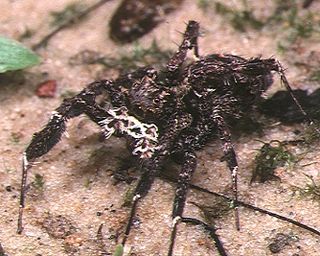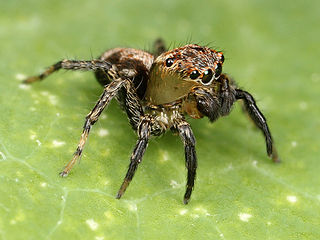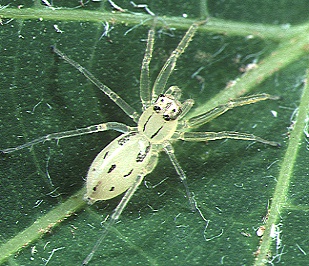Nebridia is a monotypic genus of Venezuelan jumping spiders containing the single species, Nebridia semicana. It was first described by Eugène Louis Simon in 1902, and is only found in Venezuela. It was briefly considered a synonym of Amphidraus, it was elevated to genus status in 2017.

Nicylla is a monotypic genus of Sumatran jumping spiders containing the single species, Nicylla sundevalli. It was first described by Tamerlan Thorell in 1890, and is only found on Sumatra. Briefly considered a synonym of Thiania, it was elevated back to genus status in 2017.
Thianitara is a genus of Southeast Asian jumping spiders that was first described by Eugène Louis Simon in 1903. As of August 2019 it contains only two species, found in Thailand, Indonesia, and Malaysia: T. spectrum and T. thailandica. It was briefly considered a junior synonym of Thiania until 2017, when it was revived by Jerzy Prószyński.

Zenodorus is a genus of the jumping spiders distributed from the Moluccas to Australia, including several islands of the Pacific. It was once considered a junior synonym of Omoedus, but this was later rejected by Jerzy Prószyński in 2017. At least one species, Z. orbiculatus, specializes on hunting ants.

The Spartaeinae are a subfamily of the spider family Salticidae. The subfamily was established by Fred R. Wanless in 1984 to include the groups Boetheae, Cocaleae, Lineae, Codeteae and Cyrbeae, which in turn were defined by Eugène Simon.

Salticinae is a subfamily of jumping spiders. It includes over 90% of the known species of jumping spiders. The subfamily is divided into two unranked clades: Amycoida and Salticoida.

Lyssomaninae is a subfamily of jumping spiders. It includes four genera, three from the New World.

Simonellini is a tribe of spiders belonging to the Amycoida clade of the subfamily Salticinae of the family Salticidae. The group has been treated at a variety of formal and informal ranks, with different circumscriptions, including as the subfamilies Synemosyninae and Simonellinae. Its species mimic ants and beetles.
Emertonius is a genus of spiders in the jumping spider family Salticidae.
Nepalicius is a genus of spiders in the family Salticidae. It was first described in 2016 by Prószyński. As of 2017, it contains 3 species.
Psenuc is a genus of spiders in the family Salticidae. It was first described in 2016 by Prószyński. As of 2017, it contains 11 species.
Rudakius is a genus of spiders in the family Salticidae. It was first described in 2016 by Prószyński. As of 2017, it contains 7 species.
Orienticius is a genus of spiders in the family Salticidae. It was first described in 2016 by Prószyński. As of 2017, it contains 2 species.
Padillothorax is a genus of southeastern Asian jumping spiders first described by Eugène Simon in 1901. As of April 2019 it contains only two species.

Asemoneinae is a subfamily of jumping spiders. It was created in 2015 by Wayne Maddison. Most species are found in Africa or Asia. The subfamily initially had five genera, but Hindumanes was later transferred to the subfamily Lyssomaninae.
Agorioides is a genus of spiders in the jumping spider family Salticidae. The two described species are native to Papua New Guinea.
Orientattus is a genus of spiders in the jumping spider family Salticidae.
Leviea is a genus of spiders in the jumping spider family Salticidae. The three described species are all native to Papua New Guinea.
Papuamyr is a genus of spiders in the jumping spider family Salticidae. The two described species are all native to Papua New Guinea.
Manzuma is a genus of spiders in the jumping spider family Salticidae native to Africa.







